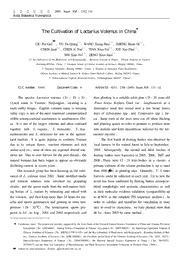
The Cultivation of Lactarius Volemus in China PDF
Preview The Cultivation of Lactarius Volemus in China
云 南 植 物 研 究 2009, Suppl .ⅩⅥ : 115~116 Acta Botanica Yunnanica The Cultivation of Lactarius Volemus in China 1 1,2 1,2 1,3 LIU Pei-Gui , YU Fu-Qiang , WANG Xiang-Hua , ZHENG Huan-Di , CHEN Juan1,4 , CHEN Ji-Yue1,5 , TIAN Xiao-Fei1,2 , XIE Xue-Dan1,2 , 1,2 1,2 SHI Xiao-Fei , DENG Xiao-Juan (1 Key Laboratory of the Biodiversity and Biogeography, Kunming Institute of Botany, Chinese Academy of Sciences, Kunming650204, China; 2 Graduate School of Chinese Academy of Sciences, Beijing 100049, China; 3 Tsinghua University, Beijing 100084, China; 4 Institute of Medicinal Plant Development, Chinese Academy of Medical Sciences & Peking Union Medical College, Beijing 100193, China; 5 Xishuangbanna Tropical Botanical Garden, Xishuangbanna 666303, China) CLC number: S646 Document Code: A Article ID: 0253 - 2700 (2009) Suppl.ⅩⅥ- 115 - 02 The species Lactarius volemus (Fr .: Fr .) Fr . then planting in a suitable adult pine (15 - 20 years old (Local name in Yunnan: Naijiangjun, meaning is a Pinus kesiya Royleex Gord var . langbianensis as a multi-milky fungus; English common name is weeping dominative wood tree mixed with a few broad leaves milky cap) is one of the most renowned commercialized trees of Lithocarpus spp . and Castanopsis spp .) for- edible ectomycorrhizal mushrooms in southwestern Chi- est . Some roots of the trees were cut off when ditching na . It is one of the largest volumes and often confused and planting spawn in order to promote to produce more together with L. rugatus, L. hatsudake, L. hyg- new rootlets and form mycorrhizae infected by the fer- rophororoides and L. deliciosus for sale in the agricul- mented mycelia . tural markets . It is quite popular in southern Yunnan The first batch of fruiting bodies was observed by due to its unique flavor, nutrient elements and rich local farmers in the natural forest in July to September, amino acid etc; some of them are exported abroad cou- 2004 . Subsequently, the second and third batches of ntries too .Due to over harvest for the past decade, the fruiting bodies were harvested in 2005, 2006, 2007 and natural biomass has been begun to appear an obviously 2008 .There were 12 - 28 fruit-bodies in a cluster; a declining current in recent years . primary estimate of the volume production is up to more Our research group has been focusing on the culti- than 1000 g m2 in planting sites . Generally, 3 - 4 times vation of L. volemus since 2001 . Some modified media harvests could be collected in each year .Up to now the and ferment solution were invented for preparing result has been confirmed by fruiting bodies ectomycor- strains, and the spawn made from the well mature fruit- rhizal morphologic and anatomic characteristics as well ing bodies of L. voelum by triturating and mixed with as their molecular evidence validation (comparability up the solution, and then keep more than 24 hours for my- to ≥96% in the complete ITS sequences analysis) . In celia and spores germination and growing in room tem- order to validate and reconfirm for inoculation in more perature ( 24 - 32℃) . The fermentation spawn pre- area to avoid its chanciness, we have planted more than pared in Jul . to Aug . 2001 and 2002 respectively and 66 ha . since 2005 by same method . Foundation items: The projectwas partially supported by the Joint Fundsofthe NationalNaturalScienceFoundationofChina and Yunnan Provincial Government (No .U0836604) , Natural Science Foundation of Yunnan (keyproject No .2007C0002Z), the Knowledge Innovation Program of Chinese Academy of Sciences (No . KSCXZ2-YW-G-025) and the Key Laboratoryof Biodiversity and Biogeography, KunmingInstitute ofBot- any, Chinese Academy ofSciences (No .KBB-200804), the President specialfundof the Chinese AcademyofSciences (No .1022, 1035) , NaturalSciences Foundation of Yunnan (No . 2004C0050M); the National Natural Science Foundation of China ( ( No . 30470011, 30770007) and the State key Laboratory of Phytochemistry and Plant Resources Sustainable Utilization in Western China (2006) . Author for correspondence; E-mail: [email protected] 1 16 云 南 植 物 研 究 增刊ⅩⅥ Fig .1 Adult pine (15-20 years old Pinus kesiya Royleex Gordvar. langbianensis as a dominative wood tree) forest .2, Technological training local farms; 3, Lactariusvolemus (Fr .: Fr .) Fr . fruiting bodies were produced at the inoculation sites; 4 and 5, Ectomycorrhizae of Pinus kesiya var. langbianensis were formed by L. volemus infection . 6, news of the front page was reported by a local newspaper Following the optimum requirements and methods ectomycorrhizae with the fungus) , and then inoculation for establishing a L. volemus plantation according to the fungous strain fermentation solution in grooves, the our primary experiment results are: last recovered tightly with original soil; 1, to make the fungous fermentation spawn solution; 4, Management after planting, such as irrigation water 2, to select a suitable symbiotic trees species for- is necessary if drought; absolutely to eliminate some harm- est (it should be the absence of trees with other com- ful weed as above mentioned; to prohibit human activity and peting fungi), to eliminate harmful weeds (such as keep away domestic animals from the plantation . Eupatorium adenophorum Spreng, English name: crofton weed) and to adjust soil pH (5.6 - 6.2); Acknowledgment: The authors gratefully acknowledge the Sci- 3, to dig15 - 20 cm wide and 8 - 15 cm deep gro- entific and Technologic Bureau of Lancang County of Yunnan oves at 5 m alternation, at same times cut off some root Province and Yunnan forestry Bureau for their assistance and or- (in order to produce new rootlets and synthesize more ganizing local farmer as well as the plantation management .
